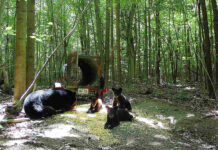In 1950, a dozen eggs cost 60 cents, a gallon of gas was just 27 cents and the Stark Soil and Water Conservation District was a fledgling agency just getting started. Now, in 2025, the organization is celebrating its 75th anniversary as an important conservation agency in the 21st century.
Stark County has changed significantly in the last 75 years, and the Stark SWCD has grown and changed as well. In 1950, Stark County’s population was just over 282,000. By 2025, however, the county’s total population reached 372,700. More importantly, there has been a significant shift in where that influx of 90,000 people settled within the county.
In 1950, Stark County’s rural population was only 81,422 — or roughly 29% of the total population. While rural numbers climbed somewhat over the next 30 years, reaching nearly 100,000 in the 1980s, by the 1990s, the rural population of Stark County had dropped below the original 1950s numbers. In 1990, just under 81,000 Stark county residents lived in rural areas — less than 22% of the total population.
While census data criteria for tracking rural populations changed in the mid-1990s, and again in 2020, the number of rural residents has only continued to decline. Stark County’s rural footprint, the land classified as rural, also shrank considerably since the 1950s. These numbers tell a story. Stark is a county ceding rural areas and rural character to urbanization and rapid growth fueled by modern suburban development.
As more and more people choose to move to Stark County, the need for housing increases, but the need to provide for rural communities and to conserve our natural resources also rises. Urban areas and populations are growing, and so are the impacts brought on by that increased development. Balancing demand and the need for conservation can be a tricky task.
Agencies like Stark SWCD provide balance between the needs of development for today and the needs of future generations through conservation efforts. Whether inspecting construction sites in our developing communities under the guidance of the Ohio Environmental Protection Agency or connecting farmers and other land stewards to valuable resources available through the Natural Resources Conservation Service and Ohio Department of Agriculture, we are here to help Stark County’s growing population. We work not only directly with the public, but with public and private sector agencies to meet the needs of a growing county.
Stark Soil and Water Conservation District has grown and adapted along with the changes of the past 75 years. As outlined in our conservation mission, “We are dedicated to conserving our natural resources by educating, guiding and assisting the citizens of Stark County.” It’s been a great 75 years, and we look forward to continuing to be of service in the future.
(Todd A. Clark is the stormwater inspector with Stark Soil and Water Conservation District. You can reach him at 330-451-7645.)













